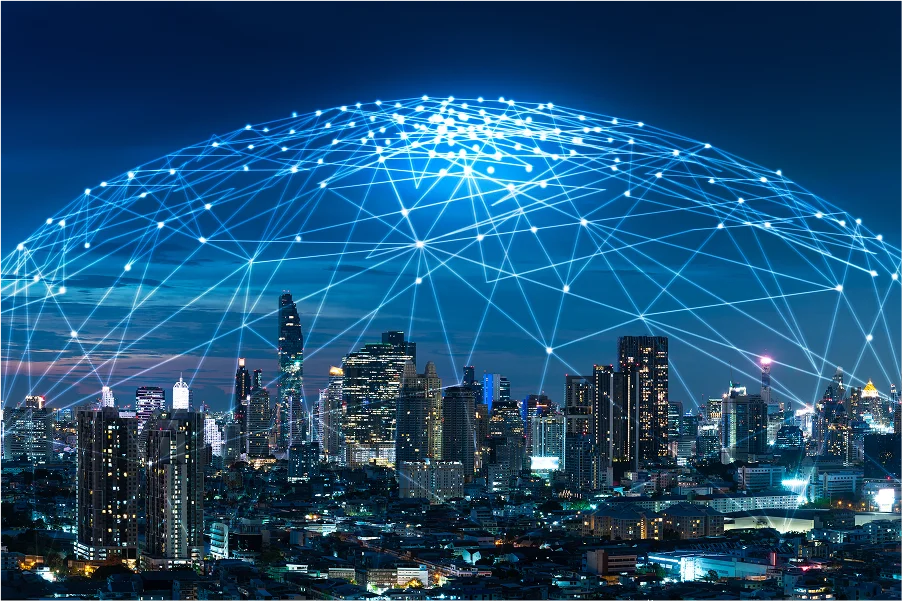The clean energy transition is no longer a simple goal. Governments and investors are pouring trillions into clean energy every year. Corporates are racing to achieve net-zero emissions, while energy companies feel the pressure to deliver reliable, affordable, and decarbonized power at scale.
But as the race to clean energy accelerates, new challenges emerge. You’re dealing with supply that spikes and drops without warning, unpredictable demand, and grids that weren’t built for two-way flows. And while you’re collecting more data than ever—from turbines, EVs, and smart meters—it’s siloed, messy, and underused.
The problem isn’t generation or demand. It’s the lack of intelligence.
So what’s the solution? You need systems that can sense, learn, and act faster than your teams ever could. That’s where AI comes in—a tool you can use to optimize, forecast, and scale without guesswork.
Let’s explore how AI in renewable energy operations—from predictive analytics that minimize downtime to intelligent grids that can handle fluctuating energy demands—is helping us manage complexity and unlock new possibilities for the future.
Why the Renewable Energy Boom Needs Better Infrastructure
The renewable energy market in the U.S. is expected to grow to $3.60 trillion by 2030 from $1.21 trillion in 2023, driven by a robust CAGR of 17.2%. Although renewable energy sources like hydropower, wind, and solar are seeing unprecedented growth, we need systems to manage this growth in real-time.
Here’s why:
- Solar and wind are unpredictable:As these weather-dependent sources fluctuate, grid operators must react in real time, sometimes discarding clean energy to keep the grid stable.
- Legacy grid systems are holding you back:Traditional power grids were designed for one-way electricity. But today, you need a two-way grid system to manage clean energy, as the old infrastructure simply can’t keep up.
- Energy farms break down without warning:Remote wind and solar farms often experience sudden failures. When that happens, operators lose time, money, and energy.
- Mountains of data go unused:Energy companies collect vast amounts of data from sensors and systems. But without innovative tools to clean this data, it goes untapped and unanalyzed.
As the renewable energy market scales up, you need more than just expanding energy farms. You need smarter systems to predict, optimize, and respond to dynamic energy needs in real time.
That’s where AI and data intelligence can help you take the lead and turn volatility into opportunity.
Reimagining Renewables with AI-Powered Intelligence
You’re generating more energy and more data than ever. Now it’s time to turn this data into real-time intelligence.
With the right insights, you can make smarter decisions across your entire energy ecosystem. From forecasting to grid optimization, you can use data intelligence and AI to unlock real value where traditional systems fall short.
Imagine this:
- Forecasting with precision:AI can forecast solar and wind energy output down to the hour, so you can plan ahead, reduce waste, and eliminate the guesswork.
- Preventing failures before they happen:With AI, you can spot potential failures in advance to avoid downtime and minimize losses.
- Orchestrating a smart grid:Imagine distributed energy storage and electric vehicles working in harmony like a virtual power plant. AI helps you achieve this, including routing power in real time, to balance supply and demand.
- Making swift adjustments to maximize efficiency:AI platforms can automatically adjust grid operations, deciding where, when, and how to route energy, optimizing your entire energy ecosystem.
What if I told you this is already happening?
For instance, Tesla’s Hornsdale Power Reserve in South Australia shows us how AI can enhance battery storage operations.
The Autobidder system, developed by Tesla, has turned a basic battery storage site into a high-frequency grid-balancing powerhouse. The result? A more stable grid and a profitable one, thanks to automated battery dispatch that responds to market signals in real-time.
Hornsdale is just the beginning. With AI, we’re entering a new era where renewable energy becomes more reliable and profitable than ever before.
Essentially, AI is no longer a theory; it’s delivering incredible results in the renewable energy market. And looks promising in the future.
- AI-driven grid optimization could unlock 175 GW of transmission capacity, without laying new wires.
- The IEA estimates $110B in annual savingsby 2035 from AI-based O&M alone.
This isn’t speculative. It’s operational. But it’s not plug-and-play.
What’s Holding AI Back in Renewable Energy
AI tools for clean energy are ready. The technology exists to predict demand, optimize supply, and prevent equipment failures before they happen.
AI-powered tools like Tesla’s Autobidder, GE’s Predix, and SparkCognition’s predictive analytics platform are already transforming how energy is forecasted, stored, and distributed. While the technology is proven and valid, the real challenge is putting it to work at scale.
Here’s what’s standing in the way:
- Messy, siloed data:Energy data is scattered across disconnected systems in different formats. Without clean, unified data, AI can’t extract valuable insights.
- Endless pilot projects:Many companies run AI experiments that never pass the pilot phase. Why? They lack a clear strategy, executive buy-in, and the infrastructure to scale.
- Skeptical teams:Internal teams, especially those rooted in traditional engineering, often don’t trust AI-driven recommendations. Without education and alignment, adoption hits a roadblock.
- Outdated systems and culture:Most energy firms weren’t built as data companies. Legacy tools and old-school ideology make it hard to transition to an AI-first approach.
- Overreliance on infrastructure expansion: Without AI, companies are forced to invest in new turbines and storage facilities just to stay afloat.
So, the question is not whether AI can be applied in the renewables space—it is how to remove these bottlenecks to unlock the future of renewable energy.
Turning AI into ROI: Lessons from Industry Leaders
With the right strategy, AI is already delivering measurable impact in renewable energy. Companies are putting it to work today, with impressive results.
What’s Working
- Ørsted uses SparkCognition’s platformto optimize assets across 5.5 GW of wind, solar, and storage. They’ve been able to predict equipment failures and schedule maintenance before things break down.
- Stem Inc. uses AI to manage energy storage for SB Energy’s 10 GWh project pipeline across North America. Their Athena platform predicts, schedules, and trades energy like a professional trader, optimizing energy flow so power is used or sold at the most profitable times.
This isn’t just the promise of green tech innovations. These are practical, profitable systems already powering the future of renewable energy.
The bottom line? To get real results from AI with strong data, you don’t need more data scientists. You need the right data intelligence infrastructure. When your data is clean, connected, and contextualized, AI can truly make an impact.
Building a Strong Foundation for AI Success
AI only works when it’s applied in the right way. That means starting small, proving value fast, and building from there. Here are some tips:
1. Forge strategic partnerships
Most renewable players don’t have deep AI expertise and many AI firms don’t understand energy well. The solution? Partner up.
For example, Ørsted is using SparkCognition’s AI platform to optimize operations across 5.5 GW of its U.S.-based wind, solar, and energy storage assets.
2. Focus on use cases that prove ROI
Start with use cases where AI delivers clear, measurable value: predictive maintenance, demand forecasting, and smart battery dispatch. Don’t chase moonshots—win small and scale fast.
For instance, GE Renewable Energy’s AI-driven predictive maintenance has reduced turbine downtime by up to 20% and extended component life by 15%.
3. Build human-AI hybrid workflows
AI is not here to replace operators but to support them. So, design systems that augment your decisions. Let AI surface the insights, and let your experts act on them.
For instance, NextEra Energy uses AI to balance supply and demand in real-time, preventing blackouts and reducing reliance on fossil fuel backups. You can use a similar strategy to achieve greater reliability and efficiency across operations.
4. Don’t skimp on cybersecurity & compliance
Grid AI can introduce new risks. This is why you need to build explainability and fail-safes from day one. Make your AI sytems trustworthy, auditable, and secure, so you can stay in control even when the grid doesn’t.
A great example is GE Vernova’s AI-powered autonomous inspection software that has achieved over 20% savings on overhaul and maintenance costs using cloud-based computer vision technology and AI/ML algorithms.
5. Foster a data-driven culture
AI adoption isn’t a tech project—it’s an organizational shift. To succeed, you must train your teams, flatten your data silos, and make data literacy and agility a part of your company DNA.
One compelling example of this approach is a German utility company implementing a comprehensive data culture initiative. By focusing on workforce enablement, improving data lifecycle management, and establishing employee-centered data governance, it enhanced decision-making and operational efficiency.
Smarter Grids Start with Better Intelligence
You don’t need to build more turbines or solar panels to stay ahead in the renewable energy revolution. The real shift comes from making your energy systems smarter, with AI at the core.
But AI alone isn’t the answer.
You need clean, connected data, trusted partnerships, and implementation that goes beyond buzzwords. With the right data intelligence strategy, you can go from just collecting data to using it for smarter, faster decisions.
This approach empowers you to build smarter infrastructure, operate more sustainably, and create a stable, future-ready path for renewable energy.

